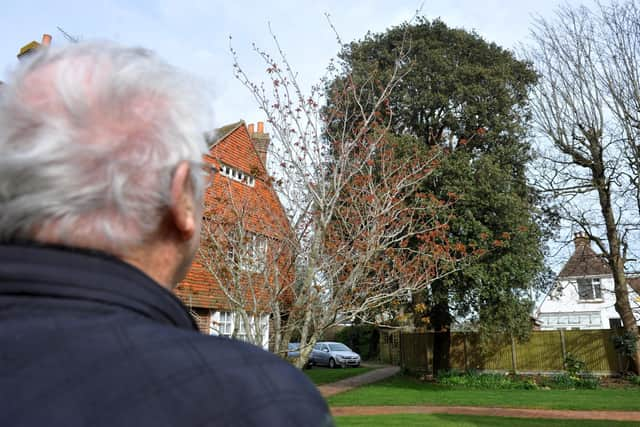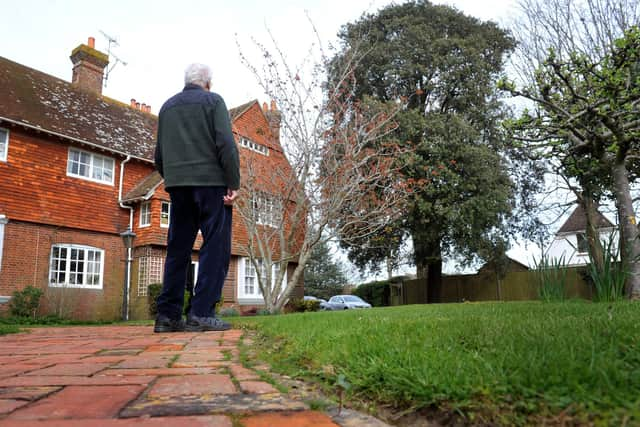Protected West Sussex village tree to be pollarded despite residents' fears - 'Destruction against nature'
and live on Freeview channel 276
The management team at Knightscroft House, in Sea Lane, Rustington, proposed to reduce the height of an evergreen oak (ilex oak).
Pollarding is a pruning system involving the removal of the upper branches of a tree, which promotes the growth of a dense head of foliage and branches.
Advertisement
Hide AdAdvertisement
Hide AdThe applicants said the plan was to contain trees ‘within proximity to the buildings’, whilst ‘maintaining the natural shape and amenity’. They also wanted to ‘create more light and reduce debris’, with significant dead wood to be removed.


However, the oak is protected by a Tree Preservation Order and other local residents were unhappy with the plan.
Keith Clarke, who lives in Knightscroft Avenue, said the imminent pollarding is ‘unnecessary’ and trimming is all it requires.
He added: “This is an evergreen oak that doesn’t need pollarding. The proposition at the moment by management is to bring it down to 16 meters, which would be done to the height of the house on the left.
Advertisement
Hide AdAdvertisement
Hide Ad"This would at least a 25 per cent reduction and is quite likely to kill it. It’s also the home of millions of birds, which nest in various places. They would become homeless and that, in itself, is a destruction against nature.”


Knightscroft House is a grade II* listed building built for Sir Hubert Parry (Jerusalem composer) and his wife (Lady Parry, well-known local suffragist).
The evergreen oak has stood outside for more than 100 years and, according to Mr Clarke, ‘it will take many years to recover’ from pollarding – ‘if indeed it ever does’.
He added: “The cannibalisation of the oak tree will be the final step in turning, what was a balanced set of grounds – that was home to wildlife as well as flower beds and grass left to a height that meant small creatures could share the grounds – into a scalped landscape no longer friendly to the flora and fauna who share the planet with us.”
Advertisement
Hide AdAdvertisement
Hide AdAnother resident, named Pat Heckman, issued an objection letter. This read: “The Ilex oak is currently home to a number of birds and squirrels. I fear the proposed works will leave them homeless too and this should not be allowed to happen.
“This is a tree that requires virtually no care at all. In fact, evergreen oak doesn’t need to be pruned, though it helps to remove dead branches regularly. Other trees in the garden have not yet recovered from the last time they were hacked.”
The application was approved conditionally by Arun District Council.
A decision notice read: “In pursuance of their powers and regulations, the Council GRANT consent for the operations to be carried out in accordance with the application and plan and subject to the conditions specified.
Advertisement
Hide AdAdvertisement
Hide Ad"The council certify that they are satisfied that the conditions specified are in the interests of good forestry or in the case of trees other than those comprised in woodlands, that the trees have an outstanding or special amenity value.”
Mr Clarke said tree surgeons arrived to start work on Friday (April 5) but had to stop due to the discovery of two bird nests.
“Spring came early by a couple of months,” he said. “They didn’t touch the oak because the birds nests were there.
"We are hoping it gets abandoned.
"The argument some people give is you’ve got to cut it back so it doesn’t reach the house – but I’ve been looking at the tree for nearly 20 years and it’s hardly grown in that time.”
Comment Guidelines
National World encourages reader discussion on our stories. User feedback, insights and back-and-forth exchanges add a rich layer of context to reporting. Please review our Community Guidelines before commenting.